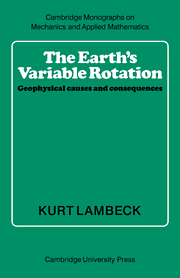Book contents
5 - The astronomical evidence
Published online by Cambridge University Press: 06 October 2009
Summary
Observations of the Earth's rotation
The astronomical observations
Precise measurements of the time elapsed between two consecutive transits of a star across a meridian determine the l.o.d. with respect to some uniform time scale. Measurement of l.o.d. therefore involves two processes: the astronomical observation of the star transits, and the establishment of a reference time. Changes in the l.o.d. are small, of the order of 10−8, and observations of numerous stars from a number of observatories, over several nights, are required in order that the signal rises above the noise of the measuring process. Thus, what is observed by astronomers is the integrated amount by which the Earth is in advance or behind after a number of days, compared with the uniform time scale. Time kept by the Earth is referred to as universal time (UT)). Strictly speaking, the time interval between successive star transits defines sidereal time, whereas UT is a mean solar time. The relation between these two systems is quite complex and is discussed in detail in most textbooks on spherical astronomy (see, for example, Smart 1962; Woolard & Clemence 1966). For geophysical purposes, the observed quantity can be considered to be the universal time. Star transits are observed with respect to an Earth-fixed meridian, defined by the station coordinates and the body-fixed x-axes.
- Type
- Chapter
- Information
- The Earth's Variable RotationGeophysical Causes and Consequences, pp. 62 - 106Publisher: Cambridge University PressPrint publication year: 1980

